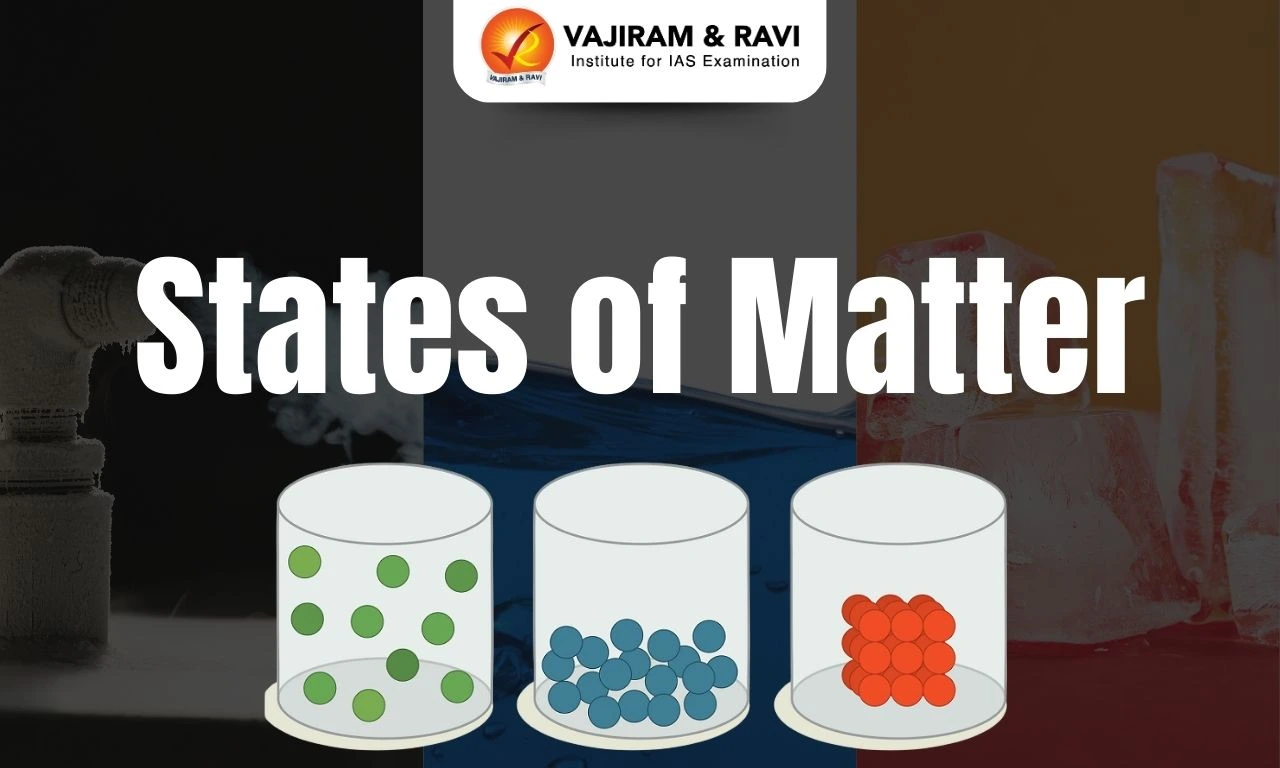Matter refers to everything that has mass and occupies space. All matter is made up of atoms and molecules. The states of matter are the distinct phases according to the molecular arrangements and behaviour. Primarily, there are three states of matter namely, solid, liquid and gas. Matter at high temperatures and pressures can exist in plasma, the fourth state. These states are interchangeable depending on the transfer of energy brought through the change in temperature and pressure.
Apart from these four states, Bose-Einstein Condensates, Neutron-Degenerate Matter, etc. are also considered states of matter but they occur only under extreme circumstances.
Different States of Matter
Under normal circumstances, there are three states of matter. These are solids, liquids and gases. Both liquids and gases are also called fluids as they can flow. Plasma is the ionised form of gas at very high temperatures. Each state has its unique set of physical properties. These differential properties are due to the unique molecular arrangements.

Solid
In solids, matter particles are closely packed together and vibrate about their fixed positions without a net movement. This is due to the strong intermolecular force between the particles present in solids. Particles of solids have very low kinetic energy. Solids have the following features:
- Rigid:
- They are rigid and have a fixed shape and volume. They do not flow easily.
- They have a high density.
- Crystalline or amorphous: Solids can be categorised as crystalline or amorphous.
- In crystalline solids, the particles are packed in a regular and repeating pattern.
- Amorphous solids such as glass don’t have regular long-range order, and are described as non-classical states of matter.
Liquid
In liquids, the particles are more loosely packed than in a solid and the intermolecular forces are weaker than in solids. Liquids have the following features:
- Fluidity:
- Liquids have no fixed shape but have a fixed volume and take the shape of the container in which they are kept.
- They flow and change their shape, hence they are not rigid, but fluid.
- Diffusion: Solids, liquids and gases can diffuse into liquids.
- The gases from the atmosphere, especially oxygen and carbon dioxide diffuse and dissolve in water, which are essential for the survival of aquatic animals and plants.
- The rate of diffusion of gases is more than that of liquids and solids.
- Compressibility: Much like solids, liquids are difficult to be compressed.
Gas
In gas, the particles are arranged irregularly and randomly and have a great space between them. They have high kinetic energy. Gases have the following features:
- Fluidity:
- A gas has neither a definite shape nor a fixed volume.
- Due to the large space between the particles, the intermolecular forces are very weak in gases. Hence, they flow easily.
- Diffusion:
- Due to the high speed of their particles and the large space between them, gases diffuse very fast into other gases as well as into liquids.
- Compressibility: Compared to solids and liquids, gases are highly compressible up to a certain limit. Thus, they can be easily transported.
- LPG and CNG are the perfect examples.
Plasma
Gases at very high temperatures begin to break down, stripping away their electrons and leaving a positively charged ion (nucleus) behind. The resulting mixture of neutral atoms, charged ions and free electrons is called a plasma. It is the fourth state of matter.
- Unique characteristics: A plasma has some unique qualities to be labelled as a "fourth phase" of matter.
- The plasma state consists of highly charged gas particles with extremely high kinetic energy.
- Like a gas, plasma does not have a definite shape or volume.
- Unlike gases, it generates and responds to electromagnetic forces due to the presence of charged particles.
- It is a fluid like gases and liquids, but unlike liquids and gases, it follows fluid dynamic equations or the Boltzman equations which include the electro-magnetic forces with the normal fluid forces of the Navier-Stokes equations.
- Normal fluids follow Navier-Stokes equations, expressing a conservation of mass, energy, and momentum.
- The motion of solids is described by Newton's Laws of Motion.
- A gas can be converted into plasma in two ways, either from a huge voltage difference between two points or by exposing it to extremely high temperatures.
- The most common state of matter: Plasma is the most common state of matter in the universe.
- Examples: Lightning, electric sparks, fluorescent lights, neon lights, plasma televisions, the Sun and all the stars, etc.
Bose-Einstein Condensate
Known as the Fifth state of matter, it is named after the scientists Satyendra Nath Bose and Albert Einstein who predicted this state of matter in theory. However, it was created in the laboratory in 1995. BEC can happen only in the case of a class of particles called Bosons.
- Formation: The BEC is formed when a gas of extremely low density is cooled to super-low temperatures.
- At a temperature near absolute zero, the atoms are hardly left with any kinetic energy. At this stage, the atoms start to clump together and enter the same energy states.
- At this point, all atoms of matter become physically identical and behave as a single atom or "super atom”.
- Uses:
- Light appears to slow down when it passes through the BEC state, helping scientists to study the particle-wave paradox.
- A BEC has many of the properties of a superfluid (fluid without friction).
- BECs can also be used to simulate conditions that exist in black holes.
Change in the States of Matter
Matter can change from one state to another when energy is added or released. For example, water exists in all the three states. Change in the state of matter is also called Phase Transition.
- Causes:
- The kinetic energy of the matter particles is directly related to the thermal energy. When heat energy is applied to the particles in a particular state, their kinetic energy increases, and consequently their thermal energy and temperature. Due to this, particles vibrate with greater speed.
- After heating to a certain point (temperature), the amount of heat applied does not cause the rise in temperature. Instead, all of the heat energy is used to increase the kinetic energy of particles in such a way that it overcomes the intermolecular force and changes into another state.
- The heat, which does not cause the rise in temperature, is called latent heat (hidden heat).
- Releasing the heat energy (by cooling) also causes the change in state but in the reverse direction.
- Further, pressure can also be used to change the states of matter. When pressure is applied, matter particles come close enough to be changed to another state.

- Interconversion of Solid and Liquid:
- Melting: When heat is applied to a solid, its particles begin to vibrate fast enough to change into the liquid state. This change is called melting. The temperature at which the solid changes to liquid, is called melting point.
- Freezing: It is the opposite process of melting in which heat is removed from a liquid until it becomes a solid.
- Interconversion of Liquid and Gas:
- Vaporisation: When the liquid is heated to its boiling point, it converts into gas.
- Condensations: It is the process which occurs when a gas loses its energy and forms a liquid at the dew point.
- Sublimation and deposition: It is a process in which a solid is directly converted to a gas bypassing the liquid phase.
- A gas can also be converted directly into a solid. It is called deposition or desublimation.
- All solids sublime, but the sublimation and deposition are detectable only in certain substances.
- A few volatile substances undergo sublimation at room temperature and pressure, such as frozen carbon dioxide (dry ice) or camphor.
Last updated on December, 2025
→ Check out the latest UPSC Syllabus 2026 here.
→ Join Vajiram & Ravi’s Interview Guidance Programme for expert help to crack your final UPSC stage.
→ UPSC Mains Result 2025 is now out.
→ UPSC Notification 2026 is scheduled to be released on January 14, 2026.
→ UPSC Calendar 2026 is released on 15th May, 2025.
→ The UPSC Vacancy 2025 were released 1129, out of which 979 were for UPSC CSE and remaining 150 are for UPSC IFoS.
→ UPSC Prelims 2026 will be conducted on 24th May, 2026 & UPSC Mains 2026 will be conducted on 21st August 2026.
→ The UPSC Selection Process is of 3 stages-Prelims, Mains and Interview.
→ UPSC Result 2024 is released with latest UPSC Marksheet 2024. Check Now!
→ UPSC Prelims Result 2025 is out now for the CSE held on 25 May 2025.
→ UPSC Toppers List 2024 is released now. Shakti Dubey is UPSC AIR 1 2024 Topper.
→ UPSC Prelims Question Paper 2025 and Unofficial Prelims Answer Key 2025 are available now.
→ UPSC Mains Question Paper 2025 is out for Essay, GS 1, 2, 3 & GS 4.
→ UPSC Mains Indian Language Question Paper 2025 is now out.
→ UPSC Mains Optional Question Paper 2025 is now out.
→ Also check Best IAS Coaching in Delhi
States of Matter FAQs
Q1. What are the major states of matter?+
Q2. Is fire a plasma?+
Q3. What is the new state of matter?+
Q4. Is Smoke a gas?+
Tags: quest states of matter

















